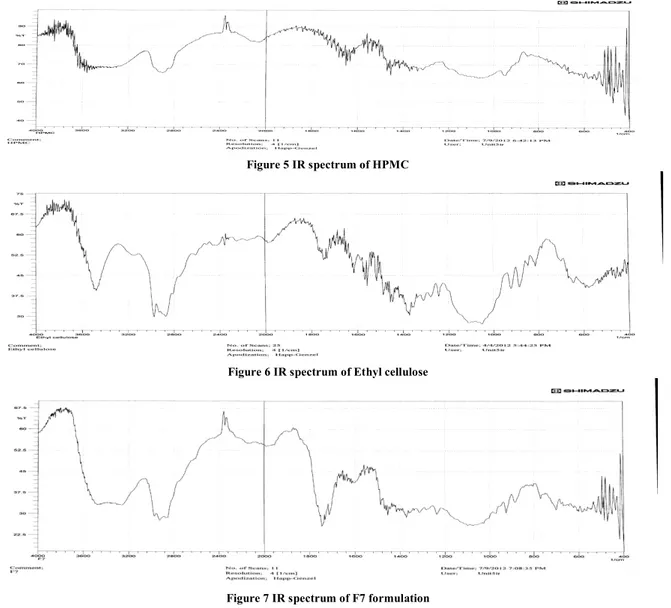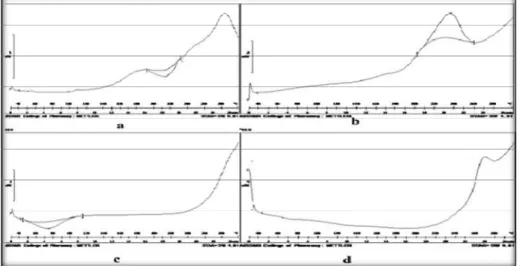INTERNATIONAL RESEARCH JOURNAL OF PHARMACY
www.irjponline.com ISSN 2230 – 8407
Research Article
PREPARATION AND IN-VITRO EVALUATION OF BACLOFEN LOADED MICROSPHERES
Polepalle Madhulatha1*, Valluru Rajashekar1, Mandalapu Sravan Kumar1, Gaddam Jayanth Kumar Reddy1, K.A Sridhar2 1
Department of Pharmaceutics, East West College of Pharmacy, Rajiv Gandhi University of Health Sciences, Bangalore, Karnataka, India
2
Department of pharmacology, East West College of Pharmacy, Rajiv Gandhi University of Health Sciences, Bangalore, Karnataka, India
Article Received on: 14/07/12 Revised on: 01/08/12 Approved for publication: 02/09/12
*Email: madhulatha.p.17@gmail.com
ABSTRACT
The present study was aimed to prepare Baclofen microspheres for sustained release using various polymers such as ethyl cellulose (hydrophobic), hydroxy propyl methyl cellulose (hydrophilic) by employing solvent evaporation technique. Drug and excipients compatibility was studied by Fourier Transform Infrared Spectroscopy and no incompatibility was observed. The obtained microspheres were evaluated for the percent drug content, entrapment efficiency and in-vitrodissolution studies. The entrapment efficiency of the obtained formulations was in between 66-88% and in-vitro release of F7 formulation showed 93% in 24 hrs. Scanning Electron Microscopy, Differential Scanning Calorimetry and X-Ray Diffraction studies were performed for F7 formulation. From the results Scanning Electron Microscopy of reveals that microspheres was found in spherical and porous nature. X-Ray Diffraction studies results showed baclofen was in amorphous form which was further confirmed by Differential Scanning Calorimetry. The curve fitting data revealed that the release of
obtained formulations follows mixed order kinetics with non‐fickian type of drug release (anomalous).
KEY WORDS: Baclofen, EC, HPMC k100, microspheres, solvent evaporation method
INTRODUCTION
The population of the patient with chronic diseases have recently been increasing. These situations necessitate taking drug for long period of time in multiple doses which can lead to increase in non-compliance. The problem would be worse for drug with short biological half-life. One of the methods to solve problem is to design the drug in sustained or controlled release formulation1. Baclofen a centrally acting muscle relaxant is indicated in long term treatment of spasticity resulting from multiple sclerosis and spinal cord injuries2. It is freely soluble in simulated gastric fluid and having a half-life of 2-4 hrs which require frequent administration produce high incidence of adverse effects3, 4. Traditionally it has been administered via intrathecal route is difficult and hazardous to patient. Marketed oral formulations are orally disintegrated tablets, conventional tablets that neither site specific nor sustained release which causes fluctuation in plasma drug levels5. Therefore it is suitable for the drug to design in sustained release formulation. However sustained release tablets have dose dumping and intra patient variations problems hence baclofen is used in microspheres preparation to deliver drug in controlled manner to improve the performance of therapeutic system6.
Aim of present study was to prepare baclofen loaded microspheres using ethyl cellulose, HPMC by solvent evaporation method and to evaluate for physical characteristic by determining % yield, drug content, particle size analysis, SEM, DSC, XRD analysis, in-vitro dissolution and release kinetics.
MATERIALS AND METHODS Materials
Baclofen was supplied by the Natco pharmaceuticals (Hyderabad, India). Ethyl cellulose and hydroxyl propyl methyl cellulose was procured from S.D fine chemicals (Mumbai, India). Dichloromethane, methanol and n-hexane was supplied from Thermo fisher scientific India Pvt. Ltd., (Mumbai, India) and span-80 from Rolex chemical industry
Method
Preparation of microspheres
The Baclofen microspheres were prepared by solvent evaporation method. Different concentrations of polymer solution along with Baclofen drug were prepared in organic solvent contain methanol and DCM in 1:1 ratio. This solution was added drop wise in to 40 ml of coconut oil containing 1.5% span 80 in a 100 ml beaker. The dispersion was stirred at 300 rpm for 1hr. After the stirring time, microspheres were centrifuged, washed several times with petroleum ether and finally with n-hexane. The filtered microspheres were dried at room temperature for 24hrs and stored in desiccators (Table 1).
EVALUATION % yield
The prepared microspheres were collected and weighed. The measured weight was divided by the total amount of all non-volatile components which were used for the preparation of the microspheres. All determinations were made in triplicate. % Yield = (Actual weight of product /Total weight of excipients and drug) * 100
Drug entrapment efficiency
Microspheres equivalent to 50 mg of the drug were taken for evaluation. The amount of drug entrapped was estimated by crushing the microspheres and extracting with aliquots of 0.1N HCl repeatedly. The extract was transferred to a 100 ml volumetric flask and the volume was made up to 100 ml using 0.1 N HCl. The solution was filtered and the absorbance was measured against appropriate blank. All determinations were made in triplicate. The amount of drug entrapped in the microspheres was calculated by the following formula:
DEE = (Amount of drug actually present/Theoretical drug load expected)*100
In-VitroRelease Studies7
remaining 24hrs. The temperature was maintained at 37 ± 0.5°C. The rotating speed of paddle was 50 rpm. A 10 ml sample was withdrawn from the dissolution medium at 1hr intervals and replaced with an equivalent volume of dissolution fluid. The amount of drug released was analyzed by spectrophotometrically at λmax 257nm. All experiments were performed in triplicate.
Drug release kinetics8
The mechanism of drug release will be determined by fitting the release data to the various kinetic equations such as zero order and first order higuchi and korsmeyerpeppas finding the R2 values of release profile corresponding to each model. Kosermeyerpeppas model will be widely used, when the release mechanism is not well known or when more than one type of release phenomenon can be involved the n value can be used characterized different release mechanism. The release of active agent from the matrix involved initial swelling will be followed by diffusion of the drug.
Drug Polymer interaction study (FTIR)
FTIR spectroscopy was performed on Fourier transform infrared spectrophotometer (IR Affinity-1, Shimadzu, Japan). The pellets of drug and potassium bromide were prepared by compressing the powders range of 4000-600cm-1. FTIR study was carried on Baclofen pure drug, physical mixture and F7 formulation.
Scanning Electron Microscopy
Scanning electron microscopy has been used to determine particle size distribution, surface topography, texture, and to examine the morphology of fractured or sectioned surface. SEM is probably the most commonly used method for
characterizing drug delivery system, owing in large to simplicity of sample preparation and ease of operation. SEM studies were carried out by JSM -848, Joel, Japan (Materials department, Indian institute of science (IISc), Bangalore, India). Dry Baclofen microsphere of best formulation (F7) and F8 were placed on an electron microscope brass stub and coated with an iron sputter. Picture of Baclofen microspheres were taken by random scanning of the stub.
Differential Scanning Calorimetric analysis9 (DSC)
Differential scanning calorimetry (DSC) analysis was conducted to ascertain the compatibility of drug with the polymer using Mettle Toledo. Pure baclofen, physical mixture, F7 (combination of both EC and HPMC) formulations were weighed (4-6mg) and placed in sealed water, frozen in liquid nitrogen and lyophilized. The coolant was liquid nitrogen. The samples were scanned at 100c to 225oc. An empty aluminium pan was used as reference. The obtained DSC thermograms are shown in Figure 9.
X-ray diffraction analysis10 (XRD)
X-ray diffraction patterns of pure baclofen, physical mixture, F7 (combination of both EC and HPMC) formulation was determined using a X-ray diffractometer (Bruker AXS D8) equipped with rotating target X-ray tube and a wide-angle goniometer (IISc, Bangalore, India). The X-ray source was Kα radiation from copper target with graphite
monochromater. The X-ray tube was operated at a potential of 40 kV and a current of 30 mA. The range (2θ) of scans was from 0 to 500c and the scan speed was 0.040 per min at increments of 0.020. The obtained XRD spectral data and diffractograms are shown in Figure 10-12.
Table 1 FORMULATION BATCHES WITH EC AND HPMC
Ingredients F1 F2 F3 F4 F5 F6 F7 F8 F9
Baclofen(mg) 300 300 300 300 300 300 300 300 300
HPMC(mg) 150 300 600 --- --- --- 450 300 150
EC(mg) --- --- --- 150 300 600 150 300 450
Ethanol(ml) 5 5 5 5 5 5 5 5 5
DCM(ml) 5 5 5 5 5 5 5 5 5
Coconut oil(ml) 40 40 40 40 40 40 40 40 40
Span 80(%) 1.5 1.5 1.5 1.5 1.5 1.5 1.5 1.5 1.5
Table 2 EVALUATION OF BACLOFEN LOADED MICROSPHERES
Formulation Yield (% w/w) %EE Drug Content
F1 64 66 68
F2 72 77 78
F3 79 82 82
F4 71 70 73
F5 79 80 82
F6 82 83 90
F7 86 88 89
F8 84 86 87
F9 81 82 86
Table 3 %CDR OF F1-F9 FORMULATIONS MICROSPHERES % CDR
Time F1 F2 F3 F4 F5 F6 F7 F8 F9
1 35.84 15.82 9.25 25.91 8.23 5.96 8.15 9.79 13.08
2 43.10 20.37 13.73 33.03 15.91 9.43 11.53 15.93 17.06
3 49.17 28.26 17.17 45.55 22.65 14.91 13.30 19.93 21.62
4 56.41 30.21 18.45 50.13 25.64 20.23 17.27 27.27 25.69
6 63.08 45.18 26.48 56.87 36.12 33.64 30.35 34.48 31.21
8 77.97 56.58 37.65 65.87 41.86 42.06 40.35 43.47 40.11
10 89.52 68.22 46.84 75.68 48.27 50.12 46.16 49.34 45.90
12 ---- 83.42 62.18 87.65 59.06 60.57 58.15 55.31 59.65
Table 4 CURVE FITTING DATA FOR ALL FORMULATION FROMF1-F9
Formulations
Zero order First order Higuchi korsmeyerpeppas
slope R2 slope R2 slope R2 n R2
F1 5.99 0.8849 -0.04 0.9536 19.64 0.9947 0.459 0.9904
F2 6.32 0.989 -0.0564 0.9288 23.868 0.9428 0.68 0.972
F3 4.12 0.9937 -0.037 0.9397 18.67 0.9131 0.75 0.9697
F4 4.746 0.9559 -0.0341 0.9679 18.06 0.9768 0.541 0.9788
F5 3.33 0.9222 -0.029 0.9958 17.517 0.9851 0.7161 0.9865
F6 3.95 0.928 -0.0379 0.9594 20.40 0.9364 0.91 0.9864
F7 4.05 0.9382 -0.047 0.9473 8.62 0.9382 0.84 0.9734
F8 3.41 0.9795 -0.037 0.9564 20.37 0.994 0.69 0.9972
F9 3.147 0.9857 -0.0325 0.9792 18.75 0.9815 0.604 0.9856
Figure 1 In-vitro release profile of microspheres prepared with HPMC
Figure 2 In-vitro release profile of microspheres prepared with EC
Figure 3 In-vitro release profiles of microspheres prepared with EC, HPMC
Figure 5 IR spectrum of HPMC
Figure 6 IR spectrum of Ethyl cellulose
Figure 7 IR spectrum of F7 formulation
(a)
(b)
Figure 9 DSC thermo graphs of (a) pure drug baclofen (b) HPMC (c) EC (d) microspheres of F7 formulation
Figure 10 XRD overlay graph of baclofen
Figure 11 XRD over lay spectrum of physical mixture
Figure 12 XRD over lay spectrum of F7 formulation
RESULTS & DISCUSSION
The aim of this study was to develop microspheres of baclofen by solvent evaporation method using hydroxy propyl methyl cellulose, ethyl cellulose and combination of these two polymers to control the release of baclofen and to enhance the uptake of hydrophilic substance across the epithelial layer. Coconut oil was used as oil phase and span 80 was used as emulsifier or stabilizer in the formulation of
Drug content and entrapment efficiency
Dissolution testing
Dissolution studies were carried for all formulations up to 24 hrs and results were shown in following Figure1, 2 and 3.
The % cumulative drug release for F1, F2, F4, were showed up to 12hrs and remaining all formulations were showed upto 24 hrs. HPMC, a cellulose ether is hydrophilic polymer mostly act as surfactant in microspheres and EC, an ethyl ether of cellulose, is a long chain of β-anhydroglucose units joined together by acetyl linkage. EC coated dosage form can be controlled by diffusion through film and demonstrate poor dissolution. Use of hydrophilic (HPMC) and lipophilic (EC) can create pores in its wall causing a continuous release of the drug. The data was given in Table 3
Release kinetics
The formulations followed zero order, first order, higuchi and peppa’s release plots stated non-fickian diffusion controlled. The linearity values in higuchi equation indicating the release of drug from microspheres as square root time dependent process based on diffusion. The n values for krosmeyer peppa’s equation indicating non fickian i.e., anomalous release, coupled diffusion and polymer matrix relaxation. Thus it was proposed that these formulations delivered their active compounds by coupled diffusion and erosion. Table 4 FTIR
The FTIR results were revealed that there is no interaction between polymer and drug. They were compatible with each other in formulation. The IR spectrums of baclofen, HPMC, EC and F7 formulations were showed in the following
Figures 4-7. The spectrum of baclofen showed characteristic absorption bands at 2900 cm-1(C-H sp3 stretch), 1530 cm -1
(COOH stretch), 1610 cm-1(N-H bending), 1180 cm-1(C-Cl stretch). The spectrum of ethyl cellulose showed characteristic absorption bands at 1050- 1120 cm-1 (C-O-C ether), 2930, 2880 cm-1 (C-H alkane stretch), 1359 cm-1(C-H alkane bending) and in HPMC 2870 cm-1(C-H alkane stretch), 1280 cm-1 (C-O alkane stretch), 920 cm-1 (C-C stretch) were observed. No significant changes were observed in the absorption bands of microspheres formulations. This indicates that drug remained intact and stable within the
polymeric microspheres.
Scanning electron microscopy
The results F7 and F8 formulations containing combination of both EC, HPMC of SEM analysis were showed in Figure 8. The F7 formulation was apparently in similar shapes with smooth surface in porous nature. The F8 formulation of microspheres was in irregular shape with porous nature having rough surface due to higher concentration of polymer that is HPMC which was not washed completely with n-hexane.
DSC
Thermograms of drug and drug loaded microspheres are shown in Figure 9. The endothermic peak of pure drug is observed at 204oc and in case of F7 formulation there is no endothermic peak. The disappearance of peak may be due to entrapment of drug in the polymer.
XRD
The X-ray diffractograms of baclofen confirms its crystalline nature, as evidence from the number of sharp and intense peaks were shown in Figures 10-12. The diffractograms of baclofen with polymer showed diffused peak indicated that the polymers amorphous nature and sharp intense peaks indicated its crystalline nature of drug. Diffraction pattern of drug spectra represents availability of crystalline peaks of drug studied at 16.60, 23.80, 330 (2θ) with corresponding to linear counts of above 20000 indicates the crystalline nature of drug. Diffraction pattern of physical mixture spectra represents availability of crystalline peaks of drug studied at 15.70, 21.80, 23.70 (2θ) with corresponding to linear counts of above 15000 indicates the crystalline nature of drug and amorphous nature of polymers showing diffused peaks. Diffraction pattern of formulation spectra represents availability of crystalline peaks of drug studied at 16.60, 23.80, 330 (2θ) with corresponding to linear counts of below 600 indicates the amorphous nature of drug.
CONCLUSION
The baclofen loaded microspheres sustained drug release for 24 hours or longer thereby it could be capable of reducing the frequency of administration and the dose‐dependent side effects with the repeated administration of conventional baclofen tablets. This type of sustained formulation will be better suitable for the spasticity patients. No drug polymer interaction was found and formulations remained stable over a long period of time.
ACKNOWLDEMENT
The authors greatly thanks to Natco Pharmaceuticals, Hyderabad, India for providing gift sample of Baclofen, IISc for performing the characterization studies of formulations and East West college of Pharmacy, Bangalore to carry out this research work very successful.
REFERENCES
1. Saffari M, Shahbazi M, Ardestani MS. Formulation and in-vitro
evaluation of eudragit L 100 microspheres of piroxicam. Nature Preced 2008:01-05.
2. Rao YM, Gande S. Sustained release effervescent floating matrix tablets
of baclofen: development, optimization and in vitro-in vivo evaluation in healthy human volunteers. DARU 2011;19(3):202-09.
3. Abdelkader H, Abdalla OS, Salem H. Formulation of controlled-release
baclofen matrix tablets II: influence of some hydrophobic excipients on the release rate and in-vitro evaluation. AAPS Pharm Sci Tech 2008
4. Ratinaraj SB, Rajveer CH, Kumaraswamy D, Bangale GS, Shinde GV.
Design and evaluation of baclofen sustained release matrix tablets. Int J Pharm Sci 2011;2(1):96-111.
5. Chattoraj S, Bandopadhyay AK. Development and evaluation of donut
matrix tablets of baclofen using mucilaginous polymer from portulaca oleracea linn. Pharm Ind 2010;72(11):1963-72.
6. Chudiwal P.D, Pawar P.L, Nagaras M.A, Mandlik S.K, Pandya S.V,
Wakte P. Statistical evaluation and optimization of influence of viscosity and content of polymer on floating microspheres of clarithromycin. Int J Pharm Tech Res 2009;1(2):1366-72.
7. Sunitha S, Amareshwar P, Santhosh kumar M. Preparation and
characterization of ondansetron hydrochloride microspheres using various cellulose polymers. Int J Current Pharm Res 2010;1(2):44-49.
8. Maurya A. K, Vishal.G, Naveen.G, Shrivastav. V. Devolopment and
Evaluation of stable microspheres of diltiazem hydrochloride, an antihypertensive drug. Int J of Pharm and Life Sci 2011;2(2):583-89.
9. Yogeshwar R, Hitesh J, Upadhyay U.M. Formulation, evaluation and
optimization of gastro retentive floating microspheres by emulsion solvent evaporation method. Int J Uni Pharm Life Sci 2012;2(3):703-31.
10. Nighute AB, Bhise SB. Prepartion and evaluation of rifabutin loaded
polymeric microspheres. Res J Pharm Tech 2009;2(2):371-74.
Source of support: Nil, Conflict of interest: None Declared



